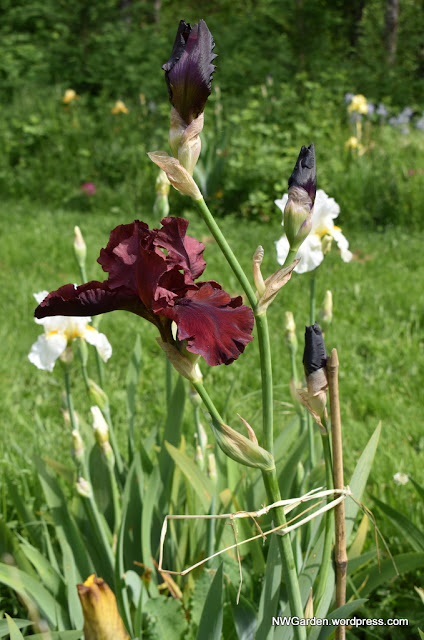 |
| Most of the apple trees that I grafted this winter are here, on north side of a raised bed. 5.11.2020 |
These trees will be in containers until this winter. I can give them more TLC this way, and move them into shade if the summer is too hot.
I also did some more iffy experiments, grafting pear onto related species that might result in miniaturization. I don't have experience with that, although you can find it on some websites. I grafted pear onto aronia, serviceberry, and Chinese and Black hawthornes. Also onto Winter Banana, which is an apple variety that supposedly is compatible with pear, so I grafted the Winter Banana onto either Bid-9 or onto an established apple tree, Winecrisp. So far, it looks like the pear on Winter Banana on Winecrisp is taking, but maybe not too enthusiastic. Ditto for the pear on Winter Banana on Bud-9, even less enthusiasm, and Pear on Chinese Haw. The others don't appear to have taken.
To keep some Winter Banana, I grafted that onto a Jonagold Tree. I thought the description sounded interesting. I also grafted Winter Banana onto some Bud-9. By the way, Bud-9 is short for "Budagovsky 9" which is a cold hardy Russian origin rootstock. Winter Banana is an apple, not a banana, but somewhere along the line, someone thought it was yellow like a banana, or something.
 |
| This is a whip & tongue graft of "Winter Banana" apple onto a Jonagold tree. 5.11.2020 |
 |
| This is a graft onto a Winecrisp apple tree. I grafted a "Winter Banana" interstock, with a pear scion. 5.11.2020 |
I also grafted all three of the chestnut cultivars onto the tree that I bought a few years ago, that was a seedling of Marissard. Buying the Marissard seedling was a mistake. Seedlings are unpredictable, may never bear, and if this tree is like its parent, might be pollen sterile. Also seedling chestnut trees can take 10 years to bear, while grafted cultivars might bear in two or three years. But it's too big to give up on, and who knows? Maybe it will have decent chestnuts some day.
I decided to graft onto this tree, scion from my other three young, grafted cultivars. Two of those trees have already produced first and even second year chestnuts, and the third has made male flowers with pollen. The challenge is, I read that chestnut grafts often don't take on other chestnut rootstocks. I used scion that I collected from Marivale, Marigoule, and Precose Magoule. I had to climb on a ladder to graft these. It looks to me like all took. There can be delayed incompatibility, but so far, so good. They are even producing male flowers. The photos below show three of the grafts. These were all whip & tongue grafts, wrapped / bandaged with 3/4" strips cut from zipper lock freezer bags and the exposed scion wrapped less tightly, with parafilm.
In the long run, it might be best to order some scion of other types to graft on other branches, and remove most of the top from this tree, other than the grafts. We'll see what it does this year.
 |
| Chestnut Graft. 5.11.2020 |
 |
| Chestnut Graft. 5.11.2020 |
 |
| Chestnut Graft. 5.11.2020 |






















